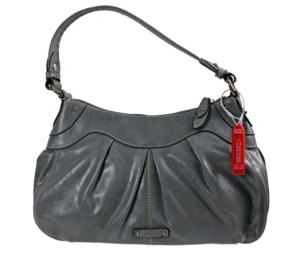 Could it be that Santa Claus is not always a jolly, giving man? Oh yeah. Take a look at this Santa. He (or I guess it could be a she) is out for a little cheer for…. himself. Regardless who they are, customers need to be watched. In this case, the store let their guard down because of the costume. Shoplifters use deception and costumes to steal.
Could it be that Santa Claus is not always a jolly, giving man? Oh yeah. Take a look at this Santa. He (or I guess it could be a she) is out for a little cheer for…. himself. Regardless who they are, customers need to be watched. In this case, the store let their guard down because of the costume. Shoplifters use deception and costumes to steal.
In this case, the Santa costume allows plenty of room to hide merchandise. Shoplifters will make or modify clothing to become a shoplifting tool. We call these “booster” items. Booster coats, dresses, skirts, pants and more. I have even seen booster “bloomers”. They are worn under a loose fitting skirt or dress. The shoplifter drops a merchandise item through what looks like a pocket in the outer garment and into the bloomers which are secured at the knee. A lot of merchandise can be concealed that way. We once caught a woman with four cordless drills including batteries concealed that way.
Other costumes include religious clothing. How about a Nun? I have caught one of those. It was a difficult “habit” for her to break. Even someone who dresses as a member of the Armed Forces, a security officer, repairman, phone company technician with tools and a toolbox. A shoplifting team may use a person like this to distract your attention or create a scene while the others steal.
Another booster item could be a false bottom gift-wrapped box. Your merchandise Items go in the bottom with a trap door. Shopping bags are yet another tool. Especially ones from your store. Our inclination is that whatever is in there, was already purchased. Or they put stolen merchandise under merchandise that they did purchase.
The general rule of thumb is that shoplifters want to blend in with your regular customer look. Take a look at this video of a customer that “blended in” but was bottomless:
If your average customer wears a suit then that is the way the shoplifter will dress. If they wear shorts and flip-flops, then that is their targeted look. But a costume that portrays confidence such as uniforms, religion, public servant… is like hiding in plain sight. We dismiss that person “because an XXX would not be stealing from me”.
If a costume makes people uncomfortable, they would tend to avoid that person. Someone dressed in an outrageous way such as a stripper (okay, not too many places to hide something), odd clothing combinations and colors or some of what we can find at the People of Walmart website probably qualify.
Of course, no story on shoplifting costumes would be complete without a creepy clown. So if I have not weirded you out too much, then happy hunting!
 December is the month when retailers are focused on driving those end of the year sales. We push as much merchandise as possible out of the stockrooms to fill the floors. Empty salesfloor spaces should be “no-no’s” during this time of the year. We re-merchandise our fixtures to get gift ideas in front of our customers. We also take steps to increase impulse buys by filling check lanes with snacks, batteries, magazines, gift cards, etc. Managers should also be looking at last year sales information to plan schedules around peak times of the day in order to avoid long lines at the registers. While all of this is important it is just as important to start planning for your end of the year wrap up.
December is the month when retailers are focused on driving those end of the year sales. We push as much merchandise as possible out of the stockrooms to fill the floors. Empty salesfloor spaces should be “no-no’s” during this time of the year. We re-merchandise our fixtures to get gift ideas in front of our customers. We also take steps to increase impulse buys by filling check lanes with snacks, batteries, magazines, gift cards, etc. Managers should also be looking at last year sales information to plan schedules around peak times of the day in order to avoid long lines at the registers. While all of this is important it is just as important to start planning for your end of the year wrap up. A New Year is just around the corner and once again resolutions are going to be made and many of those will fall by the wayside. Why does that happen? Are goals too big to achieve? Sometimes we all start off with good intentions and we just get caught up in our normal routines and we can’t seem to focus on what it was we wanted to get done. There may be a manager out there who resolves that this is the year they will meet quarterly with each employee and discuss performance. They might do well the first quarter but then as the demands of the job take up more and more time something gives and it was the meetings. I recall one of my resolutions was to be more organized at work. I had a filing system, it was called my desktop and I knew where everything was at. I would make my resolution, create a filing system and you guessed it by the end of January I was back to my old habits. My intentions were good I just wouldn’t stay focused on it and made excuses.
A New Year is just around the corner and once again resolutions are going to be made and many of those will fall by the wayside. Why does that happen? Are goals too big to achieve? Sometimes we all start off with good intentions and we just get caught up in our normal routines and we can’t seem to focus on what it was we wanted to get done. There may be a manager out there who resolves that this is the year they will meet quarterly with each employee and discuss performance. They might do well the first quarter but then as the demands of the job take up more and more time something gives and it was the meetings. I recall one of my resolutions was to be more organized at work. I had a filing system, it was called my desktop and I knew where everything was at. I would make my resolution, create a filing system and you guessed it by the end of January I was back to my old habits. My intentions were good I just wouldn’t stay focused on it and made excuses. As a manager of a retail shop, the layout of the store is probably out of your hands and there is nothing to do about it.
As a manager of a retail shop, the layout of the store is probably out of your hands and there is nothing to do about it. I wonder if Santa Clause conducts background checks on his newly hired elves? I’ve been contemplating the chaos that would take place in Santa’s workshop if he just hired any old elf to work for him. Does Santa ever get into a time crunch right around June and bring in seasonal hires to help meet timelines to get all of the toys made? Imagine the pilferage that would ensue if Santa’s Helpers haven’t been properly screened for criminal activity before being brought on board. Defective dolls might be delivered to darling little girls who deserve better. No firetrucks for a little fella because a fiendish elf stole it.
I wonder if Santa Clause conducts background checks on his newly hired elves? I’ve been contemplating the chaos that would take place in Santa’s workshop if he just hired any old elf to work for him. Does Santa ever get into a time crunch right around June and bring in seasonal hires to help meet timelines to get all of the toys made? Imagine the pilferage that would ensue if Santa’s Helpers haven’t been properly screened for criminal activity before being brought on board. Defective dolls might be delivered to darling little girls who deserve better. No firetrucks for a little fella because a fiendish elf stole it. When we think of gift boxes and wraps during this time of the year we would probably think of robe boxes, shirt boxes or jewelry boxes. Wraps would bring to mind those colorful papers and foils that we use to hide the boxes and try to camouflage the gifts inside. Then there are the ribbons that tie everything together and make the packages beautiful. The whole purpose is to protect the items we have purchased from prying eyes and snoops.
When we think of gift boxes and wraps during this time of the year we would probably think of robe boxes, shirt boxes or jewelry boxes. Wraps would bring to mind those colorful papers and foils that we use to hide the boxes and try to camouflage the gifts inside. Then there are the ribbons that tie everything together and make the packages beautiful. The whole purpose is to protect the items we have purchased from prying eyes and snoops. According to the Small Business Administration (SBA), there are more than 28 million small businesses in the United States and they account for more than 99% of businesses in the country. Small businesses employ close to 57 million people in the United States alone and are a driving force in the progress of the US economy. The good news for an entrepreneur that wants to start a business is that they are not alone, but if you are a small business in the retail industry, the problems you will encounter do not come as paperwork filings or taxes paid. Shoplifting and employee theft are two of the major causes small retail shops face financial distress during their business enterprise. It is an unfortunate problem, but the problem is there and the small business owner has to find solutions to the specific problems in their store.
According to the Small Business Administration (SBA), there are more than 28 million small businesses in the United States and they account for more than 99% of businesses in the country. Small businesses employ close to 57 million people in the United States alone and are a driving force in the progress of the US economy. The good news for an entrepreneur that wants to start a business is that they are not alone, but if you are a small business in the retail industry, the problems you will encounter do not come as paperwork filings or taxes paid. Shoplifting and employee theft are two of the major causes small retail shops face financial distress during their business enterprise. It is an unfortunate problem, but the problem is there and the small business owner has to find solutions to the specific problems in their store. I remember it like it was yesterday. It was a Black Friday morning and we had lines of customers jockeying for position at 16 front end cash registers, two pharmacy registers, a jewelry counter register and 2 registers at our electronics counter. Sure, there were a lot of people, hundreds if not a thousand at one time but we were handling it. I had our Loss Prevention team monitoring cameras, checking receipts at the front doors and walking the floor with “Security” jackets on to deter theft and prevent fights. The store management team had good plans in place for replenishing freight on the floor and giving employees breaks. I had worked with the Store Manager to control the flow of customers into our building and all had gone off without a hitch, no pushing, shoving or fights. I even had a number of police officers at our front doors aiding us with crowd control. We had really planned for every contingency, or so we thought. The one thing that we had not planned for happened and it was a major problem, our register system went down! The audible sighs, snide remarks, and expressions of anger and frustration were heard in one collective voice. All of our managers jumped into action trying to reboot registers and get systems back online. Ever so slowly we got things moving again but it was a nightmare and it made us realize the scary truth, we had not really prepared for everything as well as we thought we had. A number of shopping carts had been abandoned with Black Friday specials in them and no salesfloor staff available to re-shelve the merchandise.
I remember it like it was yesterday. It was a Black Friday morning and we had lines of customers jockeying for position at 16 front end cash registers, two pharmacy registers, a jewelry counter register and 2 registers at our electronics counter. Sure, there were a lot of people, hundreds if not a thousand at one time but we were handling it. I had our Loss Prevention team monitoring cameras, checking receipts at the front doors and walking the floor with “Security” jackets on to deter theft and prevent fights. The store management team had good plans in place for replenishing freight on the floor and giving employees breaks. I had worked with the Store Manager to control the flow of customers into our building and all had gone off without a hitch, no pushing, shoving or fights. I even had a number of police officers at our front doors aiding us with crowd control. We had really planned for every contingency, or so we thought. The one thing that we had not planned for happened and it was a major problem, our register system went down! The audible sighs, snide remarks, and expressions of anger and frustration were heard in one collective voice. All of our managers jumped into action trying to reboot registers and get systems back online. Ever so slowly we got things moving again but it was a nightmare and it made us realize the scary truth, we had not really prepared for everything as well as we thought we had. A number of shopping carts had been abandoned with Black Friday specials in them and no salesfloor staff available to re-shelve the merchandise. With Thanksgiving right around the corner, I thought it would be an appropriate time for me to ask the employers out there how thankful are you for the staff you have? I don’t mean are you just thankful you have people who work for you in a general sense but how thankful are you for what they bring to the workplace every day? Maybe you have never thought about it like that. I’m certain you are thankful that Bobby showed up on time today or Mary Jane rang up customers without a customer complaint. But have you ever looked at how you express your thanks to your team? Maybe your attitude is that you pay them and that should be enough. Perhaps you give your employees a birthday card when their birthday rolls around each year. But is that really sufficient? Is it fair for your employees to expect more from you in terms of recognition?
With Thanksgiving right around the corner, I thought it would be an appropriate time for me to ask the employers out there how thankful are you for the staff you have? I don’t mean are you just thankful you have people who work for you in a general sense but how thankful are you for what they bring to the workplace every day? Maybe you have never thought about it like that. I’m certain you are thankful that Bobby showed up on time today or Mary Jane rang up customers without a customer complaint. But have you ever looked at how you express your thanks to your team? Maybe your attitude is that you pay them and that should be enough. Perhaps you give your employees a birthday card when their birthday rolls around each year. But is that really sufficient? Is it fair for your employees to expect more from you in terms of recognition?